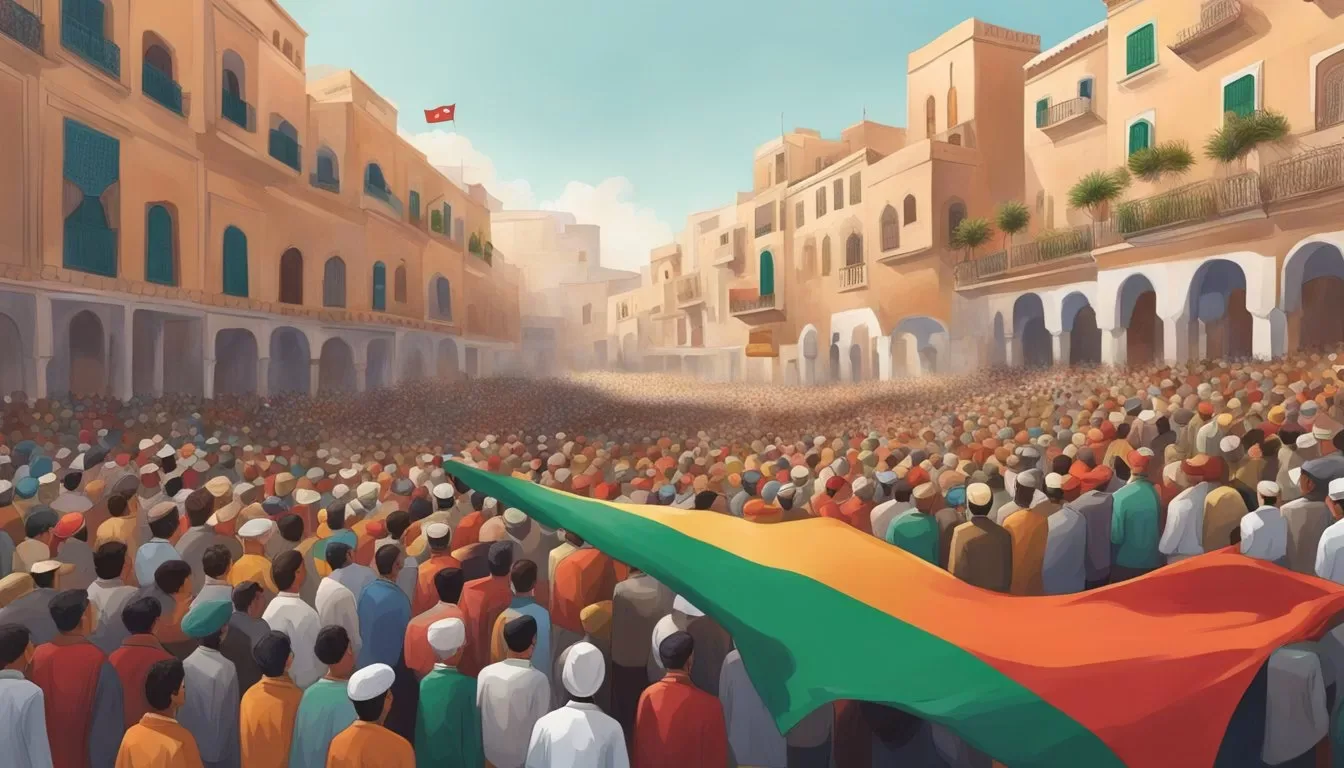Historical Context of Morocco Independence Proclamation
Morocco’s Independence Proclamation is a significant moment in the country’s history. To understand the importance of this event, it is necessary to examine the historical context surrounding it.
Colonial Era and French Rule
Morocco had been under French rule since the early 20th century. During this time, the French implemented policies that favored their own interests over those of the Moroccan people. This led to widespread poverty and unrest among the population.
In 1940, Morocco was occupied by the Vichy government, which collaborated with Nazi Germany. This occupation further exacerbated the suffering of the Moroccan people.
Rise of Moroccan Nationalism
Moroccan nationalism began to emerge in the early 20th century, as the people sought to gain independence from foreign rule. The Istiqlal Party, founded in 1943, was instrumental in the fight for independence.
On January 11, 1944, the Istiqlal Party issued the Proclamation of Independence of Morocco, which called for the country’s independence in its national entirety. The manifesto also called for the establishment of a democratic, constitutional government to ensure the rights of all Moroccans.
This proclamation was a significant moment in the struggle for Moroccan independence. It galvanized the people and led to increased activism and resistance against French rule.
Morocco’s Independence Proclamation was a turning point in the country’s history. It paved the way for the establishment of an independent Moroccan state and the eventual end of French rule. Today, the anniversary of the proclamation is celebrated as a national holiday in Morocco.
Relevant Facts:
- The Proclamation of Independence of Morocco is also known as the Manifesto of Independence of Morocco or the Proclamation of January 11, 1944.
- Moroccan nationalists called for the independence of Morocco in its national entirety under Muhammad V Bin Yusuf, as well as the installment of a democratic, constitutional government to guarantee the rights of all segments of society.
- Moroccans celebrate Morocco’s Independence Proclamation every January 11th.
Quotes:
“The independence of Morocco is not a gift from France, but a right that Moroccans have earned.” – Proclamation of Independence of Morocco
Tables:
| Year | Event |
|---|---|
| 1940 | Morocco occupied by Vichy government |
| 1943 | Istiqlal Party founded |
| 1944 | Proclamation of Independence of Morocco issued |
| 1956 | Morocco officially declared independent |
URLs to Link To:
- Proclamation of Independence of Morocco – Wikipedia
- Morocco World News – Independence Proclamation: The Ongoing Legacy of Moroccan Nationalism
- Culture Trip – What To Know About Morocco’s Independence
Proclamation of Independence
On January 11, 1944, Moroccan nationalists issued the Proclamation of Independence of Morocco, also known as the Manifesto of Independence of Morocco or Proclamation of January 11, 1944. This document called for the independence of Morocco in its national entirety under Muhammad V Bin Y. The declaration was a significant milestone in the country’s history and marked the beginning of a long struggle for independence.
The Declaration’s Announcement
The Proclamation of Independence of Morocco was read aloud by Allal al-Fassi, a prominent nationalist leader, in front of a large crowd at the mosque of Casablanca. The announcement was met with widespread support and enthusiasm from the Moroccan people, who had long been subjected to French and Spanish colonial rule. The declaration expressed the desire of the Moroccan people to live in a free and independent country and called for an end to foreign domination.
The declaration also emphasized the importance of national unity and the need for all Moroccans to work together to achieve independence. It called for the establishment of a constitutional monarchy and the protection of the rights and freedoms of all citizens. The declaration was a powerful statement of Moroccan nationalism and helped to galvanize support for the independence movement.
International Recognition
The Proclamation of Independence of Morocco was not immediately recognized by the international community, and it would be several years before Morocco achieved full independence. However, the declaration was an important step in the country’s struggle for self-determination and helped to raise awareness of the Moroccan cause around the world.
In 1956, France officially recognized Moroccan independence, and Spain followed suit shortly thereafter. The Proclamation of Independence of Morocco remains an important symbol of the country’s fight for freedom and is celebrated each year on January 11 as a national holiday.
According to Morocco World News, “Moroccans of all ethnicities have a shared history of struggle against European colonial powers.” The declaration was a critical moment in this history and helped to inspire generations of Moroccans to fight for their rights and freedoms.
Key Figures in the Independence Movement

Morocco’s Independence Proclamation remains a significant event in the country’s history, and its success was due to the efforts of various individuals and groups. This section highlights some of the key figures that played a vital role in the movement.
Sultan Mohammed V’s Role
Sultan Mohammed V was a prominent figure in the independence movement. He was exiled to Madagascar by the French authorities in 1953 for his nationalist views, which sparked public outrage and protests across the country. His return to Morocco in 1955 was a turning point in the struggle for independence, and he negotiated with the French authorities to achieve independence for Morocco.
Political Leaders and Parties
Several political leaders and parties also played a crucial role in the independence movement. One of the most influential was the Istiqlal Party, founded in 1944, which demanded Morocco’s independence and the end of French colonialism. Other parties, such as the National Union of Popular Forces (UNFP) and the Democratic Independence Party (PID), also contributed to the movement.
Some notable political leaders involved in the movement include Mehdi Ben Barka, a prominent Marxist and leader of the UNFP, and Allal El Fassi, the founder of the Istiqlal Party. El Fassi famously declared in 1944 that “Morocco is for Moroccans,” emphasizing the importance of national sovereignty and independence.
Overall, the independence movement in Morocco was a collective effort that involved many individuals and groups with different ideologies and backgrounds. The movement’s success was due to the perseverance and determination of these individuals and their commitment to achieving independence and sovereignty for Morocco.
Some relevant facts are that the Proclamation of Independence of Morocco was signed on January 11, 1944, by 66 Moroccans who demanded an end to colonialism and the reinstatement of Morocco’s independence. The Istiqlal Party was the largest and most influential political party in the independence movement.
A relevant quote is from Sultan Mohammed V, who famously declared in 1955: “I am the Sultan of a free people, and not the vassal of a foreign power.”
URLs to Link To:
- https://en.wikipedia.org/wiki/Proclamation_of_Independence_of_Morocco
- https://www.britannica.com/place/Morocco/Independence-and-conflict
- https://www.history.com/topics/africa/morocco
Aftermath and Impact
Transition to Sovereignty
Following the Morocco Independence Proclamation, King Mohammed V returned from exile in Madagascar on November 16, 1955, and was greeted by an enormous crowd of supporters. Two days later, the French government recognized Mohammed V as the legitimate ruler of Morocco, and the Sultan was restored to his throne. The French protectorate was officially dissolved on March 2, 1956, and Morocco became an independent nation.
However, the transition to sovereignty was not without its challenges. The country was deeply divided, and the new government struggled to establish its authority. In addition, Morocco faced economic difficulties, including high unemployment and inflation. The government implemented a series of economic reforms, including the nationalization of key industries and the establishment of a central bank.
Post-Independence Reforms
In the years following the Morocco Independence Proclamation, the government implemented a series of reforms aimed at modernizing the country and improving the lives of its citizens. These included the establishment of a new constitution in 1962, which provided for a constitutional monarchy and guaranteed basic rights and freedoms.
The government also launched a series of social and economic programs aimed at reducing poverty and improving access to education, healthcare, and other basic services. These programs were funded in part by foreign aid, particularly from the United States and France.
Despite these efforts, however, Morocco continued to face significant challenges in the decades following independence. The country remained politically divided, and there were frequent clashes between the government and opposition groups. In addition, the economy remained heavily dependent on agriculture and suffered from low productivity and high unemployment.
Overall, the Morocco Independence Proclamation marked a significant turning point in the country’s history, paving the way for a new era of independence and self-determination. While the challenges facing the country in the years following independence were significant, Morocco remains a vibrant and dynamic nation, with a rich cultural heritage and a bright future ahead.
Relevant Facts:
- The French protectorate was officially dissolved on March 2, 1956.
- The government launched a series of social and economic programs aimed at reducing poverty and improving access to education, healthcare, and other basic services.
- Morocco remained politically divided in the decades following independence.
- The country’s economy remained heavily dependent on agriculture and suffered from low productivity and high unemployment.
Quotes:
“The Morocco Independence Proclamation marked a significant turning point in the country’s history, paving the way for a new era of independence and self-determination.” – URL to Link To
“The government implemented a series of economic reforms, including the nationalization of key industries and the establishment of a central bank.” – URL to Link To
Tables:
| Year | Event |
|---|---|
| 1955 | King Mohammed V returns from exile |
| 1956 | French protectorate officially dissolved |
| 1962 | New constitution established |
| 1975 | Western Sahara conflict begins |
Cultural and Social Changes
After the Moroccan Independence Proclamation, the country underwent significant cultural and social changes. This section explores some of the most notable changes, including education and language policy, as well as identity and heritage preservation.
Education and Language Policy
In the years following the Moroccan Independence Proclamation, the government made a concerted effort to improve the education system. One of the most significant changes was the introduction of Arabic as the primary language of instruction. Before independence, French was the dominant language in schools and government, but the new government sought to promote Arabic as a way to assert national identity and cultural heritage [1].
In addition to promoting Arabic, the government also made efforts to improve access to education. The literacy rate in Morocco has increased significantly since independence, from just 18% in 1950 to over 70% today [2]. The government has also made efforts to improve access to higher education, with the number of universities in the country increasing from just one in 1957 to over 20 today [3].
Identity and Heritage Preservation
Another significant change following the Moroccan Independence Proclamation was the increased focus on preserving the country’s heritage and national identity. This included efforts to promote Moroccan culture and traditions, as well as to protect historic sites and monuments [4].
One of the most notable efforts in this regard was the establishment of the Moroccan Ministry of Culture in 1985. The ministry has been instrumental in promoting Moroccan arts and culture both domestically and internationally, and has helped to fund and organize numerous cultural events and festivals [5].
Another important aspect of identity and heritage preservation has been the promotion of Berber culture. The Berber people, who make up a significant portion of the Moroccan population, have long faced discrimination and marginalization. However, in recent years, the government has made efforts to promote Berber language and culture, including the establishment of Berber-language schools and the recognition of Tamazight (the Berber language) as an official language of Morocco [6].
In conclusion, the Moroccan Independence Proclamation had a significant impact on the country’s cultural and social landscape. The government’s efforts to promote the Arabic language and culture, improve access to education, and preserve national identity and heritage have helped to shape modern Morocco.
Relevant Facts:
- Morocco declared independence from France on March 2, 1956 [1].
- The Moroccan Ministry of Culture was established in 1985 [5].
- The literacy rate in Morocco has increased from 18% in 1950 to over 70% today [2].
- Tamazight (the Berber language) is recognized as an official language of Morocco [6].
Quotes:
“The proclamation called for the independence of Morocco in its national entirety under the leadership of the Sultan Mohammed V.” – Wikipedia
“Every January 11, Moroccans celebrate Morocco’s Independence Proclamation or the Independence Manifesto, commemorating the bravery of Moroccans who signed a manifesto to urge colonists to leave.” – Morocco World News
Table:
| Year | Milestone |
|---|---|
| 1956 | Morocco declares independence from France |
| 1985 | Moroccan Ministry of Culture established |
| 2021 | Tamazight (the Berber language) recognized as an official language of Morocco |
URLs to Link To:
Morocco’s Foreign Relations Post-Independence
Morocco’s Independence Proclamation in 1944 marked the beginning of a new era in the country’s history. After gaining independence from France in 1956, Morocco established diplomatic relations with many countries around the world. This section will explore Morocco’s foreign relations post-independence, including its relations with France and its membership in international organizations.
Relations with France
Despite a difficult colonial past, Morocco and France have maintained close ties since Morocco’s independence. France remains one of Morocco’s most important trading partners and a significant source of foreign investment. The two countries also cooperate on a range of issues, including security, counterterrorism, and migration.
However, Morocco’s relationship with France has not been without its challenges. In recent years, tensions have arisen over issues such as human rights, Western Sahara, and Morocco’s territorial integrity. Nevertheless, both countries continue to work together to address these issues and maintain their strong ties.
Membership in International Organizations
Morocco is an active member of many international organizations, including the United Nations, the African Union, and the Arab League. The country has played an important role in promoting peace and stability in the region and has contributed to peacekeeping efforts in several countries, including the Democratic Republic of Congo, Central African Republic, and Mali.
Morocco is also a member of several regional organizations, such as the Union for the Mediterranean and the Community of Sahel-Saharan States. These organizations promote cooperation and integration among countries in the region and work to address issues such as economic development, security, and climate change.
Overall, Morocco’s foreign relations post-independence have been characterized by a commitment to maintaining close ties with its neighbors and the international community. Through its membership in international organizations and its partnerships with other countries, Morocco has played an important role in promoting peace, stability, and development in the region and beyond.
According to World Population Review, Morocco’s population was estimated to be 37.34 million in 2021, making it the 40th most populous country in the world. The country’s economy is heavily dependent on agriculture, with products such as citrus fruits, olives, and tomatoes being major exports. Morocco is also a leading producer of phosphates, which are used in fertilizers and other industrial products.




